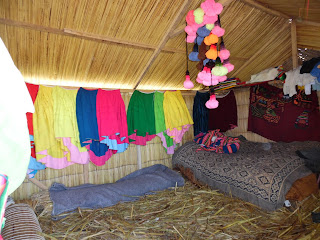Assalamualaikum,

Located between Bolia and Peru. Lake Titicaca is one of the most fascinating lakes in the world. It is situated at a very high altitude. at over 3800 meters above sea level, and a tour at Titicaca is definitely an unforgettable ecprerience for any visitors. When visiting Lake Titicaca, the town of Puno is the best place to stay, on the Peruvian side of the lake.
The town of Puno is an interesting place to visit as it is the capital of folklore of Peru. It also has a beautiful old cathedral, and it is close to many attractions of Peru like the Macchu Picchu or the town of Cusco.
Lake Titicaca is a sacred place for the Inca civilization, as the Incan mythology says that the first Inca king, Manco Capac, was born here. According to the Incan mythology, this is the place where the world was created from, when the god Viracocha came out of the lake and created the sun, the stars and the first people. You will have many places to discover on the shore of Lake Titicaca, as well as on the many islands that exist on the lake.
 |
| Puno Town view from Titicaca Lake |
 |
| Tanaman Bijirian |
Setiap hari ada beberapa perkhidmatan bas untuk ke Puno daripada Cusco. Salah satu yang terbaik ialah Turismo Bus yang menyediakan perjalanan secara pelancungan. Harga tiket ialah USD45 termasuk makan tengahari tetapi tidak termasuk entrance fees.
us akan bertolak mulai jam 0700am dan sampai di Puno jam 5pm. Persinggahan pertama ialah Andahuaylillas church satu setengah jam kemudian. Berhenti 15m bagi sesiapa yang ingin melihat "indoctrination of thBe Andean people". Perhentian kedua ialah "wiracocha Temple in Raqchi" (Main God Inca).
Jam 12.00pm berhenti untuk makan tengahari dan berehat lebih daripada satu jam disebuah bandar bernama Sicuani. Sebuah bandar dengan pemandangan yang cantik terletak disebuah lembah yang mengalirnya anak sungai dan bandar ini merupakan bandar pertanian dan ternakan.
 |
| La Raya 4400MSNM |
La Raya. Perhentian menakjubkan. Berada 4400msnm. Udara menjadi nipis dan pernafasan menjadi sesak. Pergunungan dikiri kanan masih diselaputi salji. Ini perhentian tercantik untuk mengambil gambar.
 |
| Masyarakat Asli Peru menjual cenderahati di Raqchi |
 |
| Titicaca Lake Puno |
About a two hour boat ride from Puno, on the Peruvian side of the lake, the largest of about 40 islands and the main destination is the ialand of Santa María. Seemap showing location of Uros and Taquila islands off Puno, Peru.
These floating islands are the home of theUros tribe, one which pre-dates the Incan civilization. According to their legends, they existed before the sun, when the earth was still dark and cold. They were impervious to drowining or being struck by lightning.
They lost their status as super beings when they disobeyed universal order and mixed with humans, making them susceptible to contempt. They scattered, losing their identity, language, and customs.
They became the Uro-Aymaras, and now speak Aymara. Because of their simple and precarious lifestyle, the Incas thought them worth little and accordingly taxed them very little. Yet the Uros, with their basic reed homes outlasted the mighty Incas with their huge stone temples and mountain-top enclaves.
The totora is a cattail type rush growing native in the lake. Its dense roots support the top layer, which rots and must be replaced regularly by stacking more reeds on top of the layer beneath. The islands change in size, and more are created as the need arises.
 |
| Pemandangan dalam rumah |
The islands are part of the Titicaca National Reserve, created in 1978 to preserve 37 thousand hectares of marsh reeds in the south and north sectors of Lake Titicaca. The reserve is divided into two sections,Ramis, in the provinces of Huancané and Ramis; and Puno, in the province of the same name. The reserve protects over 60 species of native birds, four families of fish and 18 native amphibians species. There are three islands in the lake, Huaca Huacani, Toranipata and Santa María.
The reserve is divided into two sections,Ramis, in the provinces of Huancané and Ramis; and Puno, in the province of the same name. The reserve protects over 60 species of native birds, four families of fish and 18 native amphibians species. There are three islands in the lake, Huaca Huacani, Toranipata and Santa María.
The floating islands are protected within the Bay of Puno and are home to 2000 or so Uros, who claim to have "black blood" are consequently immune to the cold. They call themselves be kot-suña, or people of the lake, and consider themselves the owners of the lake and its waters. They continue living by fishing, weaving and now, tourism. They catch fish for themselves and to sell on the mainland. They also catch shore birds and ducks for eggs and food. Occasionaly, if the level of the lake decreases, they may plant potatoes in soil created by the decaying reeds, but as a norm, they are not agricultural. The reed boats quite often have an animal face or shape on the prow and are a favorite photographic subject.
The Uros residents of the islands create their homes from the reeds. The roofs are waterproof but not humidity resistant. Cooking fires are built on a layer of stones to protect the reeds. Residents wear layers of clothing, mostly woolen, to protect themselves from the cold, the wind, and the sun which at this altitude can burn fiercely. Many women still wear the distinctive derby type hat and full skirts.
Kepada pembaca yang ingin melawat Uros Island, perjalanan dengan boat ke destinasi cuma mengambil masa 30m. Jangan lupa sebagai tanda kenangan sila stemkan passport anda dengan Urus Stamp dengan bayaran satu Soles.
Kepada pembaca yang ingin melawat Uros Island, perjalanan dengan boat ke destinasi cuma mengambil masa 30m. Jangan lupa sebagai tanda kenangan sila stemkan passport anda dengan Urus Stamp dengan bayaran satu Soles.
ENJOY YOUR TRIP

















































